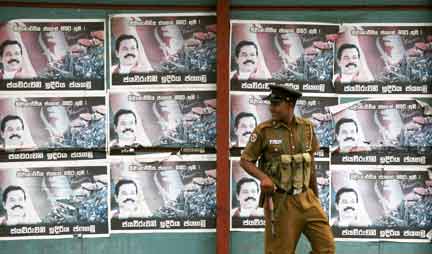Sri Lanka
Fighting resumes after government ceasefire
Article published on the 2009-04-15 Latest update 2009-04-15 13:56 TU

A Sri Lankan security officer walks past posters depicting President Mahinda Rajapaksa near the Presidential residence in central Colombo
(Photo: Reuters)
The navy attacked two LTTE boats which were approaching the coast, a navy spokesperson says, killing at least ten guerrillas. One craft was sunk and another captured, he said.
The army also says that three soldiers were killed by LTTE fire during the ceasefire but that government troops did not respond while the truce was still on.
Both sides launched new attacks as soon as the ceasefire ended at midnight, according to the pro-LTTE Tamilnet website, which claims that at least 180 civilians were killed by military rockets and artillery fire on Wednesday morning.
Army spokesperson Brigadier Udaya Nanayakkara denied that the shelling had taken place and said no new operations were launched.
With the LTTE trapped in a continually shrinking area, Sri Lankan army chief General Sarath Fonseka predicted that they face the "most humiliating defeat" they have faced since their formation in 1972. He added that they have lost more than 18,000 fighters over the last three years.
On Tuesday the LTTE said that it is ready to negotiate a permanent, internationally-backed ceasefire, an offer that has been rejected by the government.
Analyst Pakiasothy Saravanamutu believes that the government is close to military victory.
"The army is inching closer and closer towards the no-fire zone and therefore, yes, we are into a last phase," he says. "But as to how long the last phase takes is anyone’s guess."
But the end of fighting may not mean the solution of the underlying conflict, Saravanamutu believes.
"I think we can move into a post-war scenario but as to whether that post-war scenario is post-conflict scenario, I think depends entirely on a political settlement.
"I would like to think there’s a glimmer of hope – glimmer being the operative word. We need to have more in terms of demonstrable commitment and action on the part of the government to convince that they are deeply committed to a political settlement."
Two human rights groups have appealed to the Commonwealth to put pressure on both sides to end the humanitarian crisis caused by the fighting.
"The Commonwealth and its members should use their combined diplomatic influence to press the Sri Lankan government and the LTTE to cease attacks that violate the laws of war and end the humanitarian crisis in Sri Lanka’s northern Vanni region," a letter from the Commonwealth Human Rights Initiative (CHRI) and Human Rights Watch said today.
Addressing the Commonwealth Ministerial Action Group (CMAG), it said that "a two-day holiday pause in military operations was not long enough to address the desperate situation of trapped civilians".




